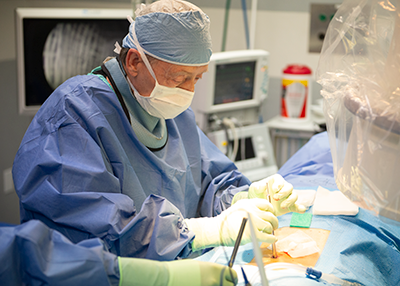Bone Fragment Removal
Vertebral bone fragment removal is performed as part of the Bonati Spine Procedures whenever a bone fragment is present that may be impinging on the spinal cord or nerve roots as they exit the spine.
Spinal fractures of the vertebrae, the bones that make up the spine, can cause bone fragments to break off, and pinch or damage the spinal nerve roots or the spinal cord. These bone fragments can be very painful and produce other symptoms such as radicular pain, tingling, numbness or weakness.

Common Causes of Vertebral Bone Fragments
• Trauma caused by a motor vehicle accident
• Sports injuries
• Gunshot wound
• Weakened bone from osteoporosis or osteoarthritis
• Spinal hardware inserted during previous failed back surgeries
Treatment begins with a thorough physical examination, as well as an examination of all imaging studies, such as X-ray, MRI and CT Scan studies.
A small incision, less than one inch in diameter, is made through which tools patented by Dr. Alfred Bonati, Founder of The Bonati Spine Institute, are then used to observe and remove bone fragments that are putting pressure on the spinal canal or nerves. The Bonati Spine Procedures are performed incrementally, one vertebral level at a time, to address the main causes of pain. This procedure may be performed in conjunction with other surgical procedures, such as: .
The Bonati Spine Procedures are performed under conscious IV sedation and local anesthesia, this allows our doctors to avoid the use general anesthesia. Through the use of local anesthesia and conscious IV sedation the patient is comfortable, responsive, and able to provide feedback to the doctors throughout the procedure. This allows our surgeons to target the source of pain with pinpoint accuracy. While in the operating room, the surgical team will confirm the patient is able to complete a series of mobility exercises and verify that the pain has been successfully treated. After the procedure, the patient is transferred to the post-operative care unit for rest and observation, and then a post-operative consultation with the surgeon will help determine if additional procedures included in the surgical plan are necessary. Follow-up surgeries are usually scheduled within a few days of the first surgery, to allow any swelling to subside. During this time, the patient will be given a regiment of walking therapy.
The Bonati Spine Institute offers a comprehensive review of MRI studies or MRI reports to prospective patients at no obligation to the patient. One of our surgeons will review your MRI scan and note each condition, its cause and severity. Then, we will discuss the findings with you to see if you are a candidate for the Patented Bonati Spine Procedures.
